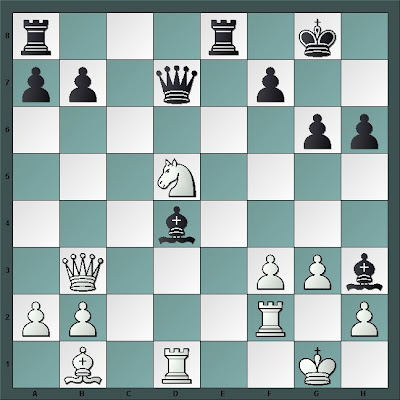(Photo by Avital Pilpel)
If there is ever a list made of the best short chess books ever, Van Amerongen's two works should get serious consideration. His 133 Malcodot Ba'Ptichot [133 Opening Traps] and 222 Tachbulot [222 Combinations] (Tel Aviv: Mofet 1973 [2nd edition] and Tel Aviv: Mofet 1963 [1st edition], respectively) are excellent.
Both books were very short: 40 pages! But length is deceiving. Each page is crammed with at least three or four (often more) combinations or traps -- as well as diagrams, hence the large total in each case. Each of the traps or combinations gets a detailed analysis, including variations. In one paragraph of his books there is often more analysis than is found in three or four pages of bad chess books.
The books -- Van Amerongen modestly calls them 'pamphlets', despite containing much more material than many books -- were cheap: the equivalent (according to measuring worth's web site) of about $5 in current US dollars (and that's suggested retail price -- in practice books are often sold below that price.) Not for him was the $20 sticker price.
Above all, the most important part of the work -- the selection of combinations and traps -- is superb. As he noted in the introduction to 222 Tachbulot (the second book to be printed), it was 'very hard to select the traps for the first pamphlet -- and doubly hard to select the combinations for this one.' Van Amerongen notes that he checked thousands of "candidate" combinations (and, presumably, at least hundreds of traps) and chose the best.
His selection of opening traps is so good that it quickly, and deservedly, became the "bible" of Israeli chess players who wish to avoid (or execute) opening traps, and to this day is used by many chess coaches to help their players improve. Van Amerongen only selected real traps -- those that occur from positions beginners-to-intermediate players actually play. Unlike some authors, he didn't think any blunder the opponent could possibly make is reason to title the refutation a combination -- as, for example, in a certain book that calls 1. e4 d5 2. exd5 Qxd5 3. Ke2?? Qe4# a "combination" by Black.
The degree of care in the selection is seen by the fact that he had gone over (he notes in the introduction of 222 Tachbulot) all the Israeli chess publications to that date to make sure he does not repeat previously-published combinations (apart from a few deliberately included "classics"). Can anybody imagine the authors of today's chess potboilers cracking open Chess Life or the British Chess Magazine to make sure they will not cheat the reader by repeating material he might have already seen?
This is what chess books are like when the author, like Van Amerongen, is modest, honest, and cares about the reader. The exact opposite, I am afraid, of certain popular chess authors these days.

